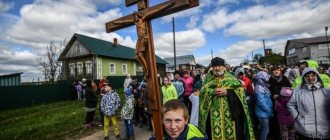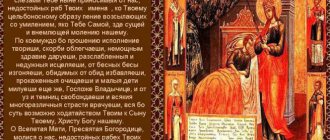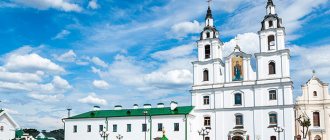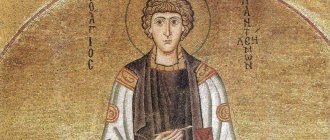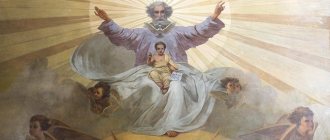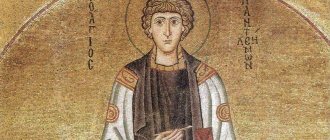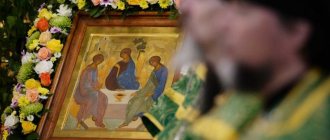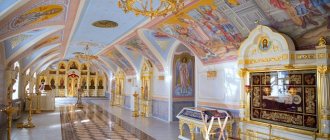Pentecost
The first years of Christianity gave believers the holiday of the Holy Trinity. The second name of the holiday is Pentecost. The icon, which announces that the spirit has descended to the apostles, is a confirmation and reminder of this event. Old Testament and New Testament prophecies about cleansing baptism with the participation of the Holy Spirit are the main idea of the image.
The moment is described in detail in the second chapter of the book “The Acts of the Apostles.” It tells how the apostles, in the name of the command of Christ, gathered daily on Mount Zion, awaiting the promised descent of the Holy Spirit. The Virgin Mary awaited this event with them.
How Baptism by Fire Changed the Apostles' Lives
After this day, the disciples of Christ changed very much. Until that day, they fell into despair and gave in to despondency, because they could not survive the death of their Teacher. Not everyone believed that the Son of God would resurrect and come to earth in a different guise, although He told them about this more than once. But the descent of the Holy Spirit on the apostles changed them dramatically. They became preachers of the Word of God who no longer betrayed their faith.
They believed, even though they knew about all the torments they would have to endure. As Christ prophesied to them, their lives would be given over to persecution, they would be ridiculed and slung with mud. Some were locked up in prison and mocked, just to “knock out” the faith from their souls and stop the endless chain of sermons. So that the burden of the apostles would not be so heavy, Christ sent His disciples the Comforter Spirit, who supported their faith and helped them endure all the hardships associated with persecution.
From now on, no one and nothing could make the apostles doubt their faith. Even during executions, beatings, and crucifixions, the spirit of Christ’s disciples became increasingly stronger.
The first Christians lived righteously, keeping all the commandments and following the teachings of the saints. They prayed every day, took communion constantly, and observed all the rules and customs. We tried to support each other everywhere and in everything, as Christ taught.
From the day of the Descent of the Holy Spirit upon the Apostles, Christian believers began to become more and more numerous throughout the world.
Initially, the apostles preached their sermons only in Palestine. And then they decided to go in different directions. The apostles cast lots to decide who should go in which direction. Andrew the First-Called was given the lot to go towards the Russian lands.
The meaning of the Feast of Pentecost
The whole week of the Holy Trinity is set aside for the celebration of Pentecost, but believers most often use a simplified name and celebrate a specific day - Trinity or Trinity Day. This is a date that belongs to the category of the twelfths, and is one of the most important in the history of Orthodox Christianity (in 2022 - June 12). It was on this day that the descent of the Divine Spirit took place, which became a central event for all humanity.
Pentecost icon
Vasilyeva A.V.
History of the holiday
The Feast of Pentecost commemorates the event of the descent of the Holy Spirit on the apostles in the form of tongues of fire, that great day when the birth of the universal apostolic Church of Christ took place (Acts II: 41-47). This holiday received the very name Pentecost because the descent of the Holy Spirit took place on the Old Testament holiday of Pentecost, which was celebrated on the fiftieth day after the Jewish Passover.
The descent of the Holy Spirit on the apostles on the day of Pentecost is described in the Acts of the Holy Apostles (Acts II: 1-18). On the fiftieth day after the Resurrection of Christ, the apostles were in the Zion Upper Room in Jerusalem, when «…
suddenly a noise came from the sky, as if from a rushing strong wind, and filled the whole house where they were.
And cloven tongues as of fire appeared to them, and one rested on each of them. And they were all filled with the Holy Spirit, and began to speak in other tongues, as the Spirit gave them utterance ”
(Acts II: 2-4).
On this day in the city, on the occasion of the holiday, there were many Jews from different cities, who, hearing the noise in the house and what was being said inside in various dialects, began to mock the apostles and say that they were drunk with sweet wine (Acts II: 13) . As the book of the Acts of the Apostles tells us, in response to this «
Peter, standing with the eleven, lifted up his voice and cried out to them: Men of the Jews, and all who live in Jerusalem!
Let this be known to you, and listen to my words: they are not drunk, as you think, for it is now the third hour of the day; but this is what was foretold by the prophet Joel: And it shall come to pass in the last days, says God, that I will pour out My Spirit on all flesh, and your sons and your daughters shall prophesy; and your young men will see visions, and your old men will dream dreams. And on My servants and on My handmaids in those days I will pour out My Spirit, and they will prophesy ”
(Acts II:14-18).
Among the Jews who came to the house there were those who listened to the apostolic sermon and asked what they should do. To this, the Apostle Peter replied that they needed to repent and be baptized in the name of Jesus Christ for the forgiveness of sins in order to also receive the gift of the Holy Spirit. There were about three thousand people who believed in Christ and willingly accepted baptism in the first days after the descent of the Holy Spirit on the apostles. This marked the beginning of the establishment of the Church of Christ on earth.
The apostles commanded the very day of the Descent of the Holy Spirit to be remembered and celebrated annually by all Christians (1 Cor. xvi, 8), (Acts xx, 16).
Establishment of a holiday
The Feast of Pentecost in the Old Testament was celebrated in memory of the giving of the Sinai legislation, the solemn entry of God into a covenant with the chosen people, and at the same time in gratitude to God for the production of new fruits of the earth (Num. 28, 26) and a new harvest (Ex. 23, 16). It was celebrated after the completion of seven weeks, that is, on the fiftieth day after Easter, and was called the Feast of Weeks (Deut. 16:9-10). By God's providence, according to the promise of the Savior (John 14:26), on this day of remembrance of the giving of the revealed law and on the fiftieth day after the Resurrection of Christ, the Descent of the Holy Spirit took place on His apostles and disciples. This event marked the entry of God into the New Testament with the New Israel - the Church of Christ, and the place of the law of Sinai was replaced by the grace of the Holy Spirit.
In the first centuries of Christianity, the holiday of Pentecost was understood as an entire period of the church year, which also included the Ascension of the Lord [1]. In the 4th century, Pentecost finally took shape not only as a special period after Easter, but also as a single holiday [2]. Following the Descent of the Holy Spirit, the Ascension of the Lord was also highlighted on a special holiday [3].
In the 4th century, Saint Basil the Great composed special prayers that are read to this day at Great Vespers, which is celebrated immediately after the liturgy on the very day of the holiday. At this service, which is one of the most solemn and beautiful services of the year, stichera are sung glorifying the descent of the Holy Spirit, and three lengthy prayers are read for the Church, for the salvation of all Christians and for the repose of the souls of the departed (including those “those held in hell” ). While reading these prayers, all worshipers are on their knees, which ends the post-Easter period, during which no kneeling or prostration is performed in churches.
The spiritual meaning of the holiday
The Feast of Pentecost, or the Descent of the Holy Spirit, has another name that most reflects the spiritual essence of this event. This holiday is also called the Day of the Holy Trinity, which indicates the participation of all Three Persons of the Divine in accomplishing the salvation of the human race. In other words, through the Descent of the Holy Spirit, the Divine Economy reached its perfect completeness: “God the Father creates the world, God the Son redeems people from slavery to the devil, God the Holy Spirit sanctifies the world through the dispensation of the Church.”
The descent of the Holy Spirit on the apostles is an event of paramount importance also because it miraculously confirmed the Sacrament of the Priesthood. For example, in the works of St. Simeon the New Theologian, the continuity of apostolic succession in the transmission of the Gifts of the Holy Spirit to the church hierarchy is emphasized: “The apostles, going out into the world, taught, preaching the word of God. Large crowds believed in Christ, and churches of the faithful were founded in cities and towns. When one of the apostles was about to leave them and go to another place or city, he ordained bishops and elders in his place... And these, ending their lives in turn, left others in their place, choosing persons worthy of such service, and whom they ordained . And thus, by succession, such order and legislation have been preserved to this day by the action of the Holy Spirit. In the same way, the traditions of the apostles and their teachings, as they received them from our Master and God of all, were transmitted by them to us.”
The descent of the Holy Spirit on the apostles was a manifestation of His power in them, the discovery of His special presence in the disciples of Christ. The Holy Spirit came to complete what was begun by the Savior - to make the apostles capable of preaching the Gospel to the whole world, to assimilate to the human race those Divine gifts that were acquired for it by the suffering of the Son of God. Thus, thanks to the event of the Descent of the Holy Spirit, man received the opportunity to see God, to participate in the gracious Kingdom of the Father and the Son and the Holy Spirit. From the outside, the celebration of Pentecost, namely the decoration of churches and houses with green branches, herbs and flowers, inherited from the Old Testament Church, symbolically expresses the power of the Holy Spirit, reviving, renewing and giving life and flourishing to everything.
Iconography
Like the image of the Ascension of the Lord, the iconography of Pentecost in Byzantine and Old Russian art is presented in two versions. Both options developed in the early Christian era and were continued in easel icon painting, as well as mosaics and fresco painting of Byzantium and Rus'.
Since the dogma of the Trinity is one of the main theological ideas revealed in the feast of Pentecost, the image of the Holy Trinity was adopted to depict this event in iconography from early Christian times. The image of the Holy Trinity in the form of three wanderers, or angels, who appeared to the forefather Abraham at the oak of Mamre, conveys the first appearance of God to man, marking the beginning of the promise of redemption, which was fully completed on the day of the descent of the Holy Spirit on the apostles. This version was called the “Old Testament Trinity.”
The oldest examples of the iconography of the “Old Testament Trinity”, or otherwise “Hospitality of Abraham”, include a fresco in the Via Latina catacomb of the 4th century, as well as a mosaic of the first half of the 6th century, which is located in the altar of the Church of St. Vitaly in Ravenna. In the post-iconoclastic period, this plot became widespread in Byzantium. In Rus', similar images have appeared since the 11th century - an example is the fresco of the St. Sophia Cathedral in Kyiv.
The angels depicted in the composition are arranged according to the principle of isokephaly, that is, sitting next to each other at the table as equal in dignity to each other, which emphasizes the equality of the Hypostases of the Holy Trinity when they are not merged [4]. The most perfect example of this type of iconography of the Holy Trinity is the famous image painted by St. Andrei Rublev in 1425-1427.
Characteristic features of the composition “Abraham’s Hospitality” may also include images of Abraham, Sarah and servants slaughtering a sacrificial calf. On some of the depictions there are no images of servants, but the forefathers Abraham and Sarah are depicted among the Angels, behind their backs.
If the image of the “Old Testament Trinity” gives an indication of the mystery of divine existence, then the icon of the Descent of the Holy Spirit reveals the providential action of the Holy Trinity in relation to the Church and the world.
The development of the iconography of the “Descent of the Holy Spirit” begins in the 6th century, its images appear in the facial Gospels (Gospel of Rabula), mosaics and frescoes. One of the earliest surviving depictions of the Descent of the Holy Spirit, a handwritten Gospel created in 586 by the Syrian monk Rabula (Laurentian Library, Florence), contains a miniature depicting the event. In the center of the composition is the Mother of God, flanked by twelve apostles in two rows under the arches of the triclinium. Directly above the Mother of God, a dove is depicted rapidly flying down, which is an image of the Holy Spirit, from which shining rays are poured onto the head of the Mother of God. Red flames burn above the heads of the Virgin Mary and the apostles.
On the Sinai icons of the Descent of the Holy Spirit of the 7th–9th centuries, dating back to the most ancient examples, the seated apostles receive the Holy Spirit in the form of descending rays of flame from the Savior blessing them from heaven.
In the St. Sophia Cathedral of Constantinople, the mosaic image of the Descent of the Holy Spirit on the Apostles (9th century) has in the center of the composition a prepared Throne (Etimasia), below which, in a circle, there are standing apostles, on whose heads rays with tongues of flame descend, and even lower are located symmetrically arranged groups of people in various clothes - the future flock of the nascent Church of Christ. This version of the iconography of Pentecost found its continuation in the mosaic temple art of the 11th-13th centuries, becoming the central composition of the dome painting (mosaics of the Cathedral of Osias Lucas in Phocis, St. Mark's in Venice).
In easel painting, the compositional scheme of this iconography of Pentecost is distinguished by details that give the image various shades of theological content.
Traditionally, icons of the Descent of the Holy Spirit on the Apostles represent the Upper Room of Zion, in which, according to the Book of the Apostolic Acts, the Apostles gathered. Books, scrolls are placed in their hands, or a blessing gesture is given to their fingers, and descending flames are written over the heads. The place of Judas Iscariot among the 12 disciples of Christ was taken by the Apostle Matthias.
In most Pentecost icons dating back to the 16th century, in the upper part of the composition, among the apostles, there is an image of the Virgin Mary. The basis for such iconography is the mention in the New Testament of the presence of the Mother of God in the Upper Room of Zion during joint apostolic prayers: «
they all continued with one accord in prayer and supplication, with some of the women and Mary, the Mother of Jesus, and with His brothers
” (
Acts I, 14).
The apostles, as a rule, in this composition are arranged in a horseshoe shape of six disciples on the left and right, with the empty space between the central figures of the apostles Peter and Paul reminiscent of the presence of the Lord Jesus Christ, as can be seen in the icons of the Last Supper [5].
In the lower part of the icon, in the dark space that is the center of the triclinium or truncated ellipse, the figure of the king can be placed, replacing the image of crowds of people from different countries who witnessed the descent of the Holy Spirit [6]. The traditional interpretation of the image of the king is the image of the people to whom the gospel sermon is addressed, represented by a single figure of its ruler. In his hands the king holds a stretched veil (ubrus), on which 12 scrolls are laid, which are a symbol of the apostolic sermon. In connection with this interpretation, next to the figure of the king, the Greek inscription κόσμος - “world” began to be placed, thanks to which the image of the king itself received the name “Tsar-Cosmos” [7]. This feature belongs to later Greek and Russian monuments belonging to the 15th–18th centuries.
The peculiar contrast of the event of the Descent of the Holy Spirit on the apostles with the image of the king of the cosmos suggests that the upper room where the apostles sit is understood as a temple that should coincide with the entire universe and reveal a new world and a new kingdom, where peace and joy in the Holy Spirit will reign.
Notes
1. For example, Tertullian calls this time “laetissimum spatium”, i.e. a most joyful period (Tertull. De orat. 23).
2. This decree is reflected in the 43rd rule of the Council of Elvira (300).
3. By the 4th century. the celebration of Pentecost became widespread, as evidenced by its mention in the works of Saints Eusebius of Caesarea, Basil the Great, Gregory the Theologian, Gregory of Nyssa, Epiphanius of Cyprus, John Chrysostom, and Blessed Augustine. There is a legend that the first Christian church was built at the site of the descent of the Holy Spirit, which was rebuilt by Queen Helen, Equal-to-the-Apostles, in the 4th century.
4. For example, in the mosaic of St. Mary the Great in Rome, 5th century, or in the Cotton Bible, of the same time, in the British Museum in London. In addition, the equality of the Hypostases in some images is emphasized by the same color clothes of the angels and their attributes (mosaic of St. Vitaly in Ravenna, 6th century). In other cases, the composition is built pyramidally, highlighting the middle angel as the main one among the others.
5. Although, according to the book of Acts, the Apostle Paul, then Saul, the persecutor of Christians who had not yet been converted to the faith, was not present in the Zion Upper Room, he is traditionally depicted on the icon of the Descent of the Holy Spirit. This is explained by the fact that the icon does not show a chronologically correct historical evidence of the holiday, but its spiritual essence. The descent of the Holy Spirit on the apostles is understood here as the beginning of the Christian Church, uniting all believers - both living and those who have departed from earthly life. Therefore, the appearance on the icon of the holiday of the Apostle Paul, the herald of the word of God, without whom the creation and triumph of the Christian Church would have been unthinkable, is quite justified.
6. In ancient Byzantine examples, the crowd of people located at the bottom of the image of Pentecost is often accompanied by the inscription “Tribes, Gentiles.” Sometimes the figure of a king and black people are introduced into it, while in Armenian-Georgian manuscripts you can see people with dog heads (Etchmiadzin manuscript of the 13th century).
7. Despite the inscription, the meaning of the figure of the king still causes different interpretations by researchers. Thus, according to one assumption, the prophet Joel was originally depicted here, whose image was allegedly distorted over time by later icon painters, who turned the prophet into a king. In support of this opinion, the prophecy itself, placed in Acts, was cited: I will pour out My Spirit on all flesh, and your sons and your daughters will prophesy; Your old men will dream dreams, and your young men will see visions, and also on male and female servants in those days I will pour out My Spirit (Joel 2:28-29). This explanation was given by some Athonite monks who did not trust the competence of the icon painters and interpreted this image according to their own considerations, despite the inscription “Cosmos”. There is an interpretation of this image also as King David, whose prophecy about the resurrection of Christ was quoted by the Apostle Peter in his sermon (Acts II) and whose grave is believed to be located on the first floor under the Zion upper room. Less common is the interpretation of the figure of the king as an image of Jesus Christ in the image of the Old Denmi, who remains with his disciples until the end of the age.
Troparion, tone 8
Blessed are you, Christ our God, / who are wise fishers of phenomena, / sending down the Holy Spirit to them, / and with them you caught the universe, // Lover of mankind, glory to you.
Kontakion, tone 8
When the merging tongues descended, / dividing the tongues of the Most High, / when the fiery tongues were distributed, / we called everything into unity, // and accordingly we glorified the All-Holy Spirit.
Greatness
We magnify Thee, / Life-giving Christ, / and honor Thy All-Holy Spirit, / Whom Thou didst send from the Father, / as Thy divine disciple.
© All rights reserved https://www.portal-slovo.ru
Decorating the Temple for the Feast of Pentecost
Trinity Day traditionally falls in the spring months. Russians celebrate the most important holiday of the Holy Trinity in accordance with ancient traditions and customs. Decorating a temple or church with fresh wreaths, birch branches, and grass is considered obligatory.
Many associate this with the ancient pre-Christian custom, when people always came to Trinity with a bunch of grass. She had to be mourned. This is how the Slavs called for rain. They believed that if all traditions and customs were followed on Trinity Sunday, then in the summer there would be a good harvest, without drought.
Iconography
Let us give a brief description of the Trinity in the form in which Andrei Rublev showed it to us. The plot of the icon speaks of the Old Testament history, which laid the foundation for one of the main dogmas of Orthodoxy.
According to a text from the Old Testament, Abraham was once visited by three mysterious travelers. He sat them down at the table and treated them to various dishes, for which he was awarded the revelation of the birth of Isaac. Two travelers soon left (according to legend, to punish the city of sinners Sodom), and one remained to talk with the future founder of the Jewish people.
The most ancient versions of the icon depict male travelers in a realistic form. The images contain the figures of Abraham and his wife Sarah, and the surroundings of the action are documented.
Rublev's icon looks a little different. The artist depicted the Trinity in the form of angels similar in appearance, but there are no images of Abraham and his wife Sarah in the composition.
Angels sit at a table on which stands a bowl with the head of a sacrificial animal - a reference to Christ's sacrifice for humanity. The angels are exactly the same, which hints at the trinity, but behind each one there is a personal background.
Behind the back of the central angel is written a tree (Tree of Life, an allegorical image of paradise lost). Usually this image is identified with God the Father. Behind the back of the angel sitting on the left is a temple (symbol of the Holy Spirit), sitting on the right is a mountain (symbol of Golgotha and the feat of Jesus Christ). Nevertheless, there are other interpretations of the deepest symbolism of the image.
The images seem to be united in an invisible circle. And at the table there is a free place where the person looking at the icon mentally sits. This is a symbol of the invitation addressed to each of us: there is a place for everyone at the table next to God.
Thus, it turns out that not the personified Father, Son and Holy Spirit are depicted at the table, but the angels symbolizing them. The artist gives visual clues, but the viewer is asked to figure out for himself which of these angels is which.
Iconography of the Feast of Pentecost
From the very beginning, the iconography of the Trinity was associated with another holiday - the Ascension of the Lord. Both dates were celebrated simultaneously until the 5th century. But then the dates were shifted, because, according to the book of the Acts of the Apostles, 10 days passed between the Ascension and the Descent of the Spirit. This is how the week of the Holy Trinity appeared. This event was reflected by icon painters who created individual works based on the book about the apostles.
The first iconographic images that can be found are reminiscent of the Ascension of the Lord. Those icons depict the apostles together with the Virgin Mary.
Later, the Virgin Mary disappeared from the canvases dedicated to Pentecost. A dove appeared in the images, which began to symbolize the condescension of the Divine. One of the most striking examples was the mosaic that was laid out on the Cathedral of St. Mark. The throne was laid out in the center, and a dove hovered nearby, announcing the descent. Around the throne are the apostles with tongues of flame descending from them.
Later, another element is added to iconographic images in honor of Pentecost. The Holy Scriptures spoke of 16 nations awaiting the descent. Therefore, representatives of these peoples began to be depicted next to the apostles. By the 12th century, a canon had been formed, which they began to adhere to when depicting Trinity Day.
A common variant of writing an icon
Most often you can find the icon of the Descent of the Holy Spirit on the Apostles in the center with the sitting Apostle Paul - a liturgical version of the spelling. It depicts the apostles sitting in a semicircle with books and scrolls in their hands and having a lively conversation. Light emanates from above them, and darkness is depicted below. Darkness symbolizes peace, until the condescension of the holy fire. People of different nationalities are also placed here, waiting for the light of the Gospel.
And what is typical in this spelling is that the apostles Peter and Paul sit in the center. Although the Apostle Paul was not at the convergence then. But the authors of many books cannot forget about him, since he is considered the supreme apostle. Therefore, iconographers place it on the icon of the Descent of the Holy Spirit on the Apostles. The photo (liturgical version) is located below, where the apostles are written with halos above their heads and tongues of flame at their mouths. This is a symbol of the fact that they were enlightened by the Holy Spirit.
In this version, under the dome of one of the churches of the Descent of the Holy Spirit on the Apostles, twelve disciples of Christ are depicted in a circle. The king appears in the middle. He has twelve scrolls in his hands. Above the head of this figure, instead of a halo, there is the inscription “Cosmos”. The figure in the form of a king represents a universe filled with different peoples. The apostles will have to go around the world and enlighten them all.
Icon "The Descent of the Holy Spirit on the Apostles"
From the very beginning, icon painters solved the problem of correct execution of the theological meaning of the date. The creators were faced with the task of depicting the descent of the spirit through the apostles, but this idea seemed allegorical and could not be executed without nuances. The composition “Teacher and Student,” which was common among the Romans and Greeks, was taken as the basis for the canonical icon. The structure of the canvas suggested an image of a central figure surrounded by his students.
Holy Spirit in Orthodoxy
The idea of trinity at each stage of the development of Christianity was different. According to the Gospel, the Spirit is one of the manifestations of God. It was he who gave birth to holiness, and also gave humanity the Son, born physically by an earthly woman.
Development of ideas about the Holy Spirit
Throughout the existence of Christianity, the trinity has been treated differently. The Middle Ages were characterized by the idea that the Spirit was assigned the role of servant of the Father or the Son. The understanding of the trinity came much later. The trinitarian model of baptism was adopted only in the 20th century and became one of the main dogmas.
Orthodox prayers to the Holy Spirit
About the fulfillment of desires
The Holy Spirit, illuminating all paths with His light and providing help in any trouble! May Thy instruction and blessing, Thy help and great mercy, not pass me by, humbly asking the servant of God (name). I pray for forgiveness of my sins and for the cleansing of my soul from all evil and wickedness. I thank You for Your saving and I glorify You ever and ever. My gaze will not turn away from Your deeds, my lips will not tire of offering prayers of thanksgiving to You. I want to be near You and carry Your Word forever. Let my need disappear and my need (desire) be fulfilled according to Your will. In the name of the Father, and the Son, and the Holy Spirit. Amen.
Heavenly King
Heavenly King, Comforter, Soul of truth, Who is everywhere and fulfills everything, Treasure of good things and Giver of life, come and dwell in us, and cleanse us from all filth, and save, O Good One, our souls.
Another prayer
Heavenly King, All-merciful Comforter, Soul of Truth, proceed from the Father eternally and rest in the Son, the unenviable source of divine gifts, sharing them with everyone as you wish, by whom we too were unworthy of sanctification and the sign of Him on the day of our baptism! Look upon Your servant for prayer, come to us, dwell in us, and cleanse our souls, so that we may be prepared for the dwelling of the Most Holy Trinity. Hey, O All-Good One, do not abhor our uncleanness and sinful wounds, but heal me with Your all-healing anointing. Enlighten our mind, so that we understand the vanity of the world and what is in the world, revive our conscience, so that it silently proclaims to us what should be done and what should be swept aside, correct and renew the heart, so that it does not exude evil thoughts and inappropriate desires day and night. Tame the flesh and extinguish with Your dewy breath the flame of passions, through which the precious image of God darkens in us. Drive away the spirit of idleness, despondency, greediness and idle talk from us, give us the spirit of love and patience, the spirit of meekness and humility, the spirit of purity and truth, so that, having corrected the weakened hearts and knees, we unslothfully flow along the path of the holy commandments, and thus avoiding all sin and fulfilling all righteousness, let us be worthy to have a peaceful and shameless death, to enter into heavenly Jerusalem, and there we will worship You together with the Father and the Son, singing forever and ever: Holy Trinity, glory to You. Amen.
For fear and anxiety
“Holy Soul! Fill the entire universe with yourself, and give life to everyone, but move away from bad people, I humbly pray to Thee: do not disdain the uncleanness of my soul, but come and dwell in me and cleanse me from all sinful filth. With Your help, I will live the rest of my life in repentance and doing good deeds, and thus I will glorify You with the Father and the Son forever and ever. Amen!
Before you start
Heavenly King, Comforter, Soul of truth, Who is everywhere and fulfills everything, Treasure of good things and Giver of life, come and dwell in us, and cleanse us from all filth, and save, O Good One, our souls. Bless, Lord, and help me, a sinner, to complete the work I have begun, for Your glory. Lord Jesus Christ, the Only Begotten Son of Your Father without beginning, You declared with Your most pure lips that without Me you cannot do anything. My Lord, Lord, with faith in my soul and heart spoken by You, I fall down in Your goodness: help me, a sinner, to complete this work, which I have begun, in You, in the name of the Father and the Son and the Holy Spirit, through the prayers of the Mother of God and all Your saints . Amen.
Holy Spirit in Orthodoxy
Photo: Orel-eparhia.ru
The Church teaches that a person must honor the entire Holy Trinity at once, since all of these are hypostases of the one God. For simplicity of perception, priests suggest that the Father is the mind, his Son is the word, and the Holy Spirit is the soul. Together they form a single whole, as in ordinary life, where the mind, word and soul are inseparable from each other.
According to a number of interpreters of the Holy Scriptures, the Holy Spirit should also be understood as God’s power in direct action, for which there are no obstacles. To better understand this idea, it is worth considering the meaning of the phrase “the sun entered the house.” It does not mean that the luminary itself was in the room, but only speaks of the sun’s rays that penetrated the room, illuminating everything around. At the same time, the Sun itself remained in the sky. In the same way, God, thanks to the Holy Spirit, is able to be in many places at the same time.
Awareness of this is an important factor strengthening the faith of Orthodox Christians. They remember that the Lord is omnipresent, he is simultaneously in different places, not leaving his followers without help and support.

